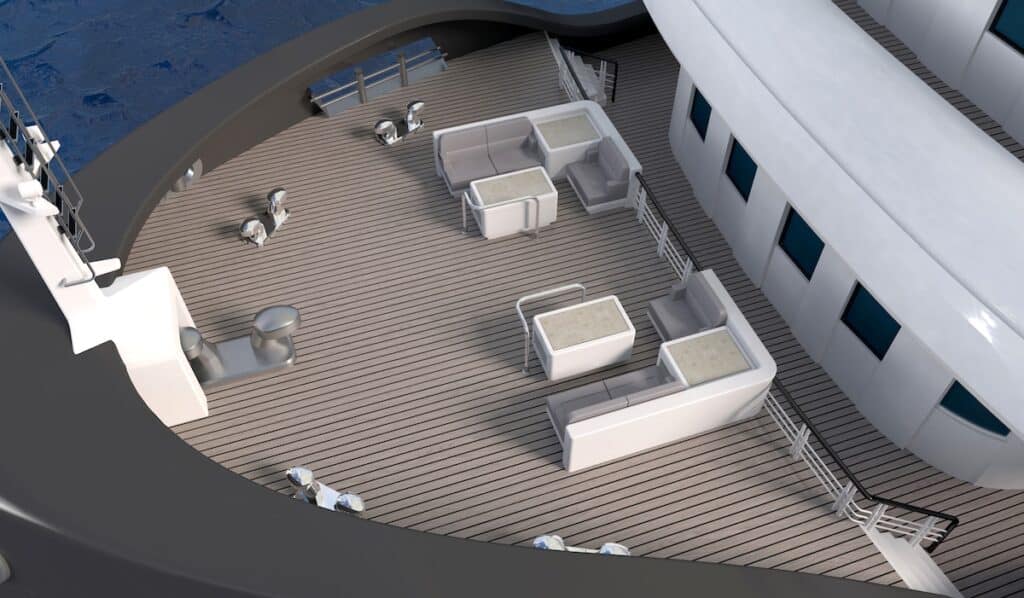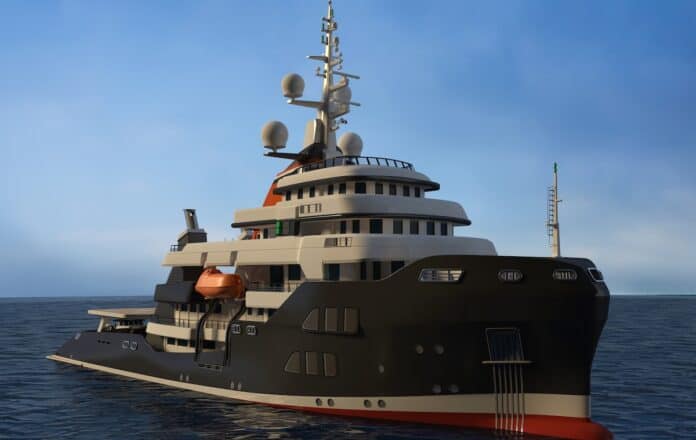LP Design UK has unveiled Project Iceberg, an explorer yacht that draws inspiration from the rugged nature of ocean-going working ships.
Features of Project Iceberg include the celebration of engineered elements, with cranes, ladders, and robust deck fittings left exposed.
The eight-deck vessel measures 220ft with 1,900 GT, with capability taking precedence over opulance, a philosophy the designers say opens the door to a highly efficient build strategy, potentially involving a skilled commercial shipyard paired with a specialist in yacht interiors to deliver comfort where it truly counts.
“My lifelong yachting experience has taken me aboard some of the most luxurious superyachts, but it was my time on some of the toughest working ships that truly shaped my vision of what an explorer yacht should be,” explained Richard Liebowitz, owner of LP Design UK.
“Experiences like North Sea trials aboard the mighty 100-metre tug Oceanic or a journey to the North Pole on a former seismic survey ship were far more influential than anything I encountered on luxury yachts. That’s the inspiration behind Project Iceberg.”

The vessel is billed as a budget-conscious explorer with clever optimisation of economy finishes inside and out and a safety first approach, aimed at the owner who seeks the security of real ocean-going vessels, built for demanding environments with dimensions to support exploration.
In order to reach remote destinations, Project Iceberg is planned to be built to Lloyd’s +100A1 classification and engineered for 1D Ice Class certification, making her suitable for light ice conditions.
“Living in a working port with commercial and military ships coming and going, I’ve always admired the practical, purposeful construction of these ships,” explained Richard.
“Their systems and heavy-duty details are there for a reason — and we wanted to adopt the same philosophy for Project Iceberg.”
Vessel features include the selection of a hybrid diesel-electric system, with the adoption of Azipod propulsion units that can rotate 360 degrees. The system is paired with bow thrusters.
In addion, a substantial anchor system has been specified.
Living in a working port with commercial and military ships coming and going, I’ve always admired the practical, purposeful construction of these ships.
Richard Liebowitz
Project Iceberg is also equipped with a helipad designed to handle aircraft up to 18,000lbs, with CAP 437 compliance.
The exterior also incorporates an orange stack, which houses a glazed atrium providing access to the the sundeck, and a pool deck with two separate swimming pools, each capable of being set to different temperatures and a bar area.
In addition to supporting aerial operations, the helideck serves a dual function by sheltering the yacht’s two primary tenders, measuring 10.4 metres and 8.5 metres respectively.
Forward, the bow deck has integrated settees designed to withstand the force of green water washing over the deck during heavy seas.
EXO Line
The four uppermost decks feature a sunbathing area, a Portuguese bridge, a bar and two pools, a viewing parapet, and an observation deck with an outdoor dining area.
There is also a forward-facing observation lounge with windows providing a 180-degree panorama and fixed seating with hydraulic shock absorbers for stability and comfort.
For the crew, there are private crew cabins and a dedicated crew fitness suite.
Project Iceberg represents the latest addition to the EXO line, which began with M/Y STEEL, a 55-metre (180-foot) explorer yacht designed by LP Design UK and built by Pendennis Shipyard.




